Goat Breeds For Cold Weather
If you live in a colder climate, you will need to take the weather into consideration when beginning your goat operation. Colder Winters present a number of challenges that will need to be addressed with goats, and starting with the right breeds can make this task easier.
What are the six best goat breeds for cold weather? Six goat breeds that are especially cold-hardy are the:
- Alpine
- Oberhasli
- Saanen
- Toggenburg
- Kiko
- Nigerian Dwarf
When looking for a breed of goat to raise in your cold climate, you will want to learn as much as possible about your options. Read on to learn more about these six breeds and what causes them to be hardier in the colder weather.
Best Goat Breeds To Purchase For Cold Weather Climates
The Alpine 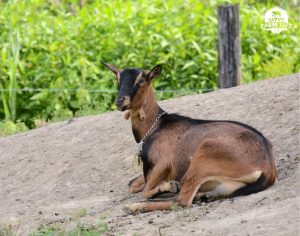
The Alpine is a hardy and efficient goat native to the Swiss Alps, and in the 19th century, it was used on steep pastures in France that sheep could not access.
These goats are agile and athletic and can navigate steep and rocky terrain with ease. Alpines have been relied upon for their productive milk yields for years and are now the most popular dairy goat in France.
Alpine goats are medium-large in size and average 135 – 200 pounds at maturity, depending on the sex of the animal. They have short-medium hair of many different colors and markings and have tall, erect ears. They have tall horns, and many of them have wattles and beards, regardless of gender.
Alpines are highly efficient producers on scarce natural feed and thrive in dry terrain in both cold and warm climates. In wet, humid conditions, they are more prone to internal parasites and foot rot but are otherwise very healthy and hardy. They are generally friendly and curious with their human handlers but can be competitive with one another.
The Oberhasli 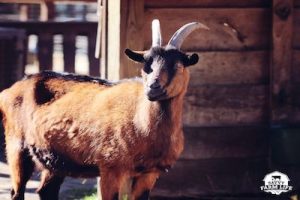
While the Alpine above is also known as the French Alpine, the Oberhasli is sometimes referred to as the Swiss Alpine. They are closely related to their French cousins, and many Oberhasli goats available in the US have been crossed with Alpines for purposes of genetic diversity. They are typically friendly and gentle with humans but like Alpines, can be competitive within the herd.
Oberhasli goats are more limited in coloring and come almost exclusively in the “Chamoisee” (sham-wah-zay) color, which is a chestnut body with black limbs and black on the back and face. They are of medium size, weighing between 120 and 150 pounds, and whether they are horned or polled depends on the specific lineage. Most have wattles, and the males have beards.
Oberhasli goats are another highly efficient breed, able to produce ample amounts of milk even in harsh conditions. Like the Alpine, they are able to thrive in dry conditions, whether very cold or warm, but are more susceptible to parasites in humid and damp weather.
The Saanen 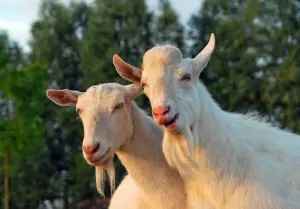
Saanen goats are another breed originating from the Swiss Alps and are highly adaptable to both cold and warm climates. They can have long hair or short hair that is almost always white.
They can be horned or polled and have medium-sized erect ears. Saanens are the largest of dairy goat breeds, with females weighing between 130 and 145 pounds at maturity. They are known as “gentle giants” with their calm and docile temperaments.
Saanan goats are known for their milk production and hardiness. They have high parasite resistance and thrive in almost any type of weather. In fact, some farmers even claim that the Saanen produces the best in cooler climates, though this has not been well-documented or researched.
The Toggenburg 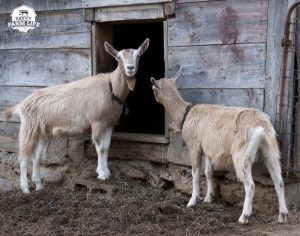
Toggenburgs are another Swiss breed native to the region and bred with other local breeds due to their hardiness. They have thick coats with longer fringes of hair, making them especially cold-tolerant, and their coats come in a variety of colors.
They are more compact than other dairy breeds, topping out at 120-150 pounds and having short legs, and they come in both horned and polled varieties. They are bold and curious and have little fear toward both humans and other animals.
Toggenburgs produce a high amount of milk with a low-fat percentage, making their milk less compatible with making cheese. The cheese they do produce, however, is considered by many to have a distinctive and strong flavor. These goats are known for their tolerance of low temperatures, and they actually prefer colder climates.
The Kiko 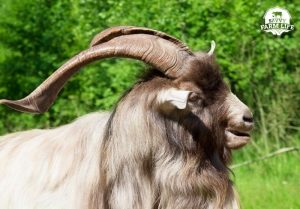
The Kiko is a breed of goat developed in New Zealand by crossing dairy goats with the hardy feral goats that roamed the landscape.
The resulting breed was able to thrive in the wide range of climates and environments to which they are native, and they perform well in both cold, dry climates as well as warm and humid climates (making them one of the few breeds of goat that performs well in the sub-tropical southeastern US).
Kikos are a meat breed – they are known for producing high amounts of meat with even low-quality and scarce forage. They kid easily and usually need no assistance, they are rarely afflicted with parasites or foot problems, and they are efficient foragers.
They are hardy and resilient and have been bred over the years to perform exceptionally well with very little maintenance. Kiko goats do not have traits that are as standardized as many other breeds, but they are stocky, with bucks reaching 200-300 pounds at maturity.
The Nigerian Dwarf 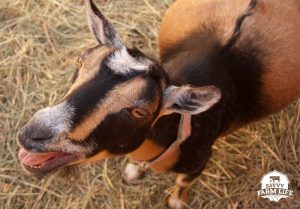
As its name implies, the Nigerian Dwarf originated in West Africa. While Nigeria is not known for its cold weather, the Nigerian Dwarf has a place on this list for its exceptional tolerance and hardiness in a wide range of climates, including Northern regions.
The Nigerian Dwarf is much smaller than most other breeds of goat and is known for its ample production of high-butterfat milk. They only reach around 75 pounds at maturity – their small stature and docile, playful personalities make them hugely popular among 4H and FFA students. Nigerian Dwarf goats do well in a variety of climates, and their thick coats make them remarkably resilient in cold weather.
Cold Weather Goat Breeds: Dairy, Meat, and Fiber
Goats, in general, are hardy animals, and any breed can be raised successfully in a colder climate, provided you take measures to protect them from freezing temperatures and strong winds. One factor that you need to consider before deciding on a breed is how you will be using your animals. Goats come in a few “categories”: dairy goats, meat goats, and fiber goats.
Many of the most productive dairy goats originated from colder climates like Switzerland and the Netherlands. While most goats are generally cold-hardy, breeds that are native to Northern climates will have a leg-up when it comes to freezing temperatures.
Goat milk is the most popular form of dairy in many countries, including many of the Northern European countries, which can be one reason that many of the most productive of breeds were originally developed in these areas.
While goat milk is popular around the world, goat meat is also very popular in areas such as Africa, South America, Central America, Australia, and the Middle East. Because these countries are relatively warm (and usually dry), most goat breeds are native to warm and arid climates. While many meat goats can thrive in colder climates, they are not typically native to Northern regions.
Fiber goats like the Angora have the potential to be cold-hardy because of their plentiful coats, but they also tend to be less resilient than other breeds. In fact, Angora goats have been called the most “delicate” of goat breeds and are more susceptible to various parasites. For this reason, even with the abundant coats, we would not call fiber goats especially hardy.
Because of the origin of these breeds, five of the six breeds on our list are known for milk production. Some, however, make excellent dual-purpose breeds and can be used for both milk and meat. Consider the purpose for which you are raising goats as you are researching breeds.
Any Goat Can Be A Cold-Weather Goat
Almost any goat can thrive in cold weather, assuming the right precautions and accommodations are provided. But if you start out with a breed that is either native to a cold climate or especially well-adapted to a variety of regions, you will be at an advantage over other warm-weather goat breeds.
It is always a good idea to match your ideal breed with the climate in which you live, as this can mean the difference between a high-maintenance and a very low-maintenance animal. While goats are worth their weight as both pets and productive livestock, the less maintenance required, the more enjoyable it can be to raise them (and the more free time you have to spend with them – even if that free time means you will need to be in your snowsuit, boots, and gloves).
You can learn more about goats and other homestead animals in my latest articles here!
